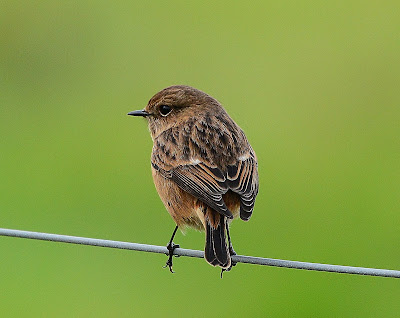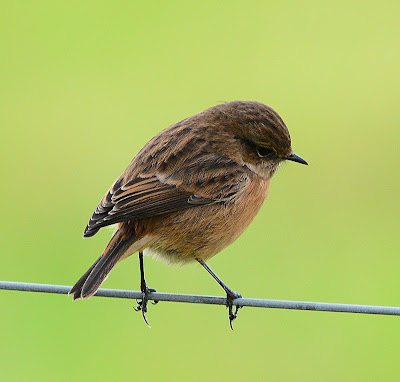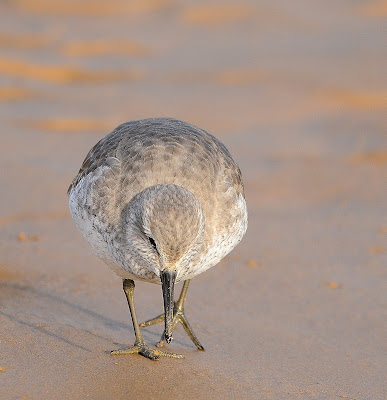Set off early as planned on being on Cley beach for a sea watch at first light and got there with just enough light to pick out a few birds flying out to sea: Large skeins of "grey geese," big strings of cormorants, a few Great crested grebe on the water as well as a east bound pair of Red breasted mergansers and a West bound Red throated diver. Bit nippy in the wind and air temp just 5C so gloves and woolly hat. I headed off to check the sea in Weybourne as the sun emerged.
Here, several turnstone were messing about on the beach offering the first photos of the day, albeit in poor light still.
 |
| The white edges on this bird's wing feathers indicate a 1st winter one |
 |
| Great camo. |
I sat down on the shingle for another sea watch but still just a selection of gulls and numerous cormorant. Suddenly, through the binoculars and heading straight at me a bird that had me grasping for the camera. A real bulky, light coloured gull.
I noted the important points, size, bill colour, shading on the tail and also noted, as can be seen in this photo the primary feathers at the wing tips are clearly white and basically unmarked. A 1st year Iceland gull, first one of this age I have seen for many years. I fired off endless photos, forgetting the settings were for the previous turnstone. I flicked the dials to improve to get a shot to show indeed an Iceland and to rule out Kumliens, which the primary feathers indicated it could not be.
 |
| More evidence showing a definite 1st year Iceland gull |
 |
Plumage ticks all the boxes. Bill shape and shade, noticeable white collar behind the head, pattern on tail and the plumage detail of the upper wing. The white primaries very evident here.
|
Pleased with this I then set off with a plan to work my way west. Next stop, Warham Greens by High Sand Creek campsite but nothing of note here after a quick scan so on to Holkham NNR and Lady Anne's Drive. Here, 1000's of wigeon either side of the drive. Redshanks and Curlews also in good number. On the fence as I drove in, a splendid Stonechat posed well for a few snaps from the car before I got out and used a few trees to get a little closer.
As can be seen on the final photo, the light was now good with a reasonably cloudless sky as I set off towards the beach. Plenty on Lady Anne's Drive to photo.
 |
| Egyptian goose coming into land |
 |
| Greylag goose overhead |
 |
| Well plumaged adult curlew |
 |
| Smart drake wigeon |
 |
| Hovering female kestrel |
 |
| Arrival of wigeon |
 |
| Another curlew |
 |
| Tried to read the info on the ring on this redshank, too distant |
 |
| Lapwing |
 |
| Another neat wigeon drake |
 |
| Wigeon spooked by a Marsh harrier |
 |
| Yet another curlew |
 |
| More redshank |
 |
| Very distant female Marsh harrier |
 |
| Hovering male kestrel by the Lookout Cafe |
Having checked the pines I wandered off along the beach towards Wells. Brent geese and a few flyover Shelduck before I headed to the dunes for more sea watching. A group of 4 Knot were feeding in the cordoned off area.
 |
| Flyby Shelduck |
 |
| Good light on these 4 Knot. |
I arrived at the dunes and set up the scope. On the water a relatively close in Great Northern Diver but this was soon moved on by a dog owner throwing a ball in near to it so I missed a good photo. Much further out, several Red breasted merganser pairs, Great crested grebe, 2 female Eider and a raft of Common scoter. Couple of really long distance shots here, up to 500 yards away minimum.
 |
| Red breasted merganser pair |
 |
| 2 Common scoter and female Eider |
I wandered back noting that the 4 Knot were now considerably closer. Photo opportunity.
 |
| Note leg colour. Bird on the left shows olive green legs = adult whilst the yellow legged bird will be a 1st winter one. |
Pleased with these I returned to the car with just a few minutes on the ticket left. A Pied wagtail flicked around by the cafe
Next stop, Brancaster Staithe by the Sailing club. I parked facing the water to eat my lunch and, as usual, Black headed gulls sussed me out immediately. About 9 appeared and demanded sandwiches. They were disappointed. A Herring gull picked up a mussel, flew up and dropped it on the hard surface. After 5 more attempts the shell broke and the gull got its snack.
 |
| Herring gull enjoying his sea food snack |
 |
| Adult Black headed gull |
By now the light had gone, too late for Titchwell so a brief wander around Thornham Harbour where more waders were noted, a flock of skylark and another distant Marsh Harrier, a male this time. I then left and headed home. Wonderful day.
 |
| Hard work being a curlew in deep mud |
 |
| Flyby curlew showing a shorter bill, indicating 1st year bird, perhaps. |
Species List:
- Great Northern Diver
- Red throated Diver
- Great Crested grebe
- Cormorant
- Little egret
- Mute swan
- Greylag goose
- Pink footed goose
- Brent Goose
- Canada goose
- Shelduck
- Egyptian goose
- Mallard
- Wigeon
- Tufted duck
- Eider
- Common scoter
- Red breasted merganser
- Red kite
- Common buzzard
- Marsh harrier
- Kestrel
- Pheasant
- Moorhen
- Coot
- Oystercatcher
- Turnstone
- Lapwing
- Knot
- Redshank
- Curlew
- Black headed gull
- Herring gull
- Lesser black backed gull
- Great black backed gull
- Iceland gull
- Common gull
- Wood pigeon
- Collared dove
- Barn Owl
- Skylark
- Meadow pipit
- Pied wagtail
- Robin
- Blackbird
- Redwing
- Fieldfare
- Mistle thrush
- Blue tit
- Great tit
- Wren
- Reed bunting
- Stonechat
- Chaffinch
- Goldfinch
- House sparrow
- Starling
- Jay
- Magpie
- Jackdaw
- Rook
- Carrion crow











































No comments:
Post a Comment